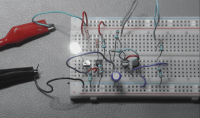Analogue LED fader/dimmer with linear brightness curve.

Use the FET square law to linearize the brightness of a LED, so a linear brightness curve is achieved.
This project is a spin-off of my LED fade contest entry :
https://www.elektormagazine.com/labs/analogue-led-fader-with-linear-intensity-using-light-feedback,
in which i used 2 other approaches (LDR feedback method and current squaring method) to linearize the brightness of a LED in order to get a fairly linear dimming/fading curve.
Another approach to linearize the brightness of a LED is using the FET square law to get a semi-exponential/square current through the LED when inputting a linear ramp to the circuit.
I wanted to experiment with this idea and the result is a new small circuit based on a PUT relaxation oscillator and a MOSFET differential amplifier.
At node (1) in the circuit, the triangular waveform, generated by the PUT oscillator, is present. For more information on PUT circuits, check :
https://sites.google.com/site/roelarits/home/put-or-tut
R4 charges C1 and R3 discharges C1. So R4 determines the steepness of the positive slope and R3 determines the steepness of the falling slope.
Q3 and Q4 form a MOSFET differential amplifier which has a very high input impedance, thus not influencing, while buffering the triangular waveform that is present over C1.
The gate of Q4 is set to approximately 2,7V (with R8 and R9) which is around the gate threshold voltage of the MOSFET. Q3 will start conducting as soon as the voltage at node (1) reaches it's gate threshold voltage, which typically is about 2V.
The current through the LED will not increase linear with the triangular input voltage applied, but will follow a square curve due to the FET square law, that defines the relation between the gate threshold voltage and the drain current of the FET. (See info in attachment).
The result is that the LED will fade in and out with a pretty linear brightness curve.
With C1 = 33uF, the period of the triangular waveform will be about 3 seconds, meaning 1,5 sec for fade in and 1,5 sec for fade out.
When you want a different frequency, just change C1.
Use a high efficiency LED to get enough brightness even with currents below 10mA.
Use a decent electrolytic capacitor with a low ESR and leakage for C1. The other components are not critical.
The circuit is dimensioned to be used with a power supply of 5V. When using higher supply voltages, R5 and R7 need to be adapted.
All resistors are 0.25W/10%.
https://www.elektormagazine.com/labs/analogue-led-fader-with-linear-intensity-using-light-feedback,
in which i used 2 other approaches (LDR feedback method and current squaring method) to linearize the brightness of a LED in order to get a fairly linear dimming/fading curve.
Another approach to linearize the brightness of a LED is using the FET square law to get a semi-exponential/square current through the LED when inputting a linear ramp to the circuit.
I wanted to experiment with this idea and the result is a new small circuit based on a PUT relaxation oscillator and a MOSFET differential amplifier.
At node (1) in the circuit, the triangular waveform, generated by the PUT oscillator, is present. For more information on PUT circuits, check :
https://sites.google.com/site/roelarits/home/put-or-tut
R4 charges C1 and R3 discharges C1. So R4 determines the steepness of the positive slope and R3 determines the steepness of the falling slope.
Q3 and Q4 form a MOSFET differential amplifier which has a very high input impedance, thus not influencing, while buffering the triangular waveform that is present over C1.
The gate of Q4 is set to approximately 2,7V (with R8 and R9) which is around the gate threshold voltage of the MOSFET. Q3 will start conducting as soon as the voltage at node (1) reaches it's gate threshold voltage, which typically is about 2V.
The current through the LED will not increase linear with the triangular input voltage applied, but will follow a square curve due to the FET square law, that defines the relation between the gate threshold voltage and the drain current of the FET. (See info in attachment).
The result is that the LED will fade in and out with a pretty linear brightness curve.
With C1 = 33uF, the period of the triangular waveform will be about 3 seconds, meaning 1,5 sec for fade in and 1,5 sec for fade out.
When you want a different frequency, just change C1.
Use a high efficiency LED to get enough brightness even with currents below 10mA.
Use a decent electrolytic capacitor with a low ESR and leakage for C1. The other components are not critical.
The circuit is dimensioned to be used with a power supply of 5V. When using higher supply voltages, R5 and R7 need to be adapted.
All resistors are 0.25W/10%.



Mises à jour de l'auteur